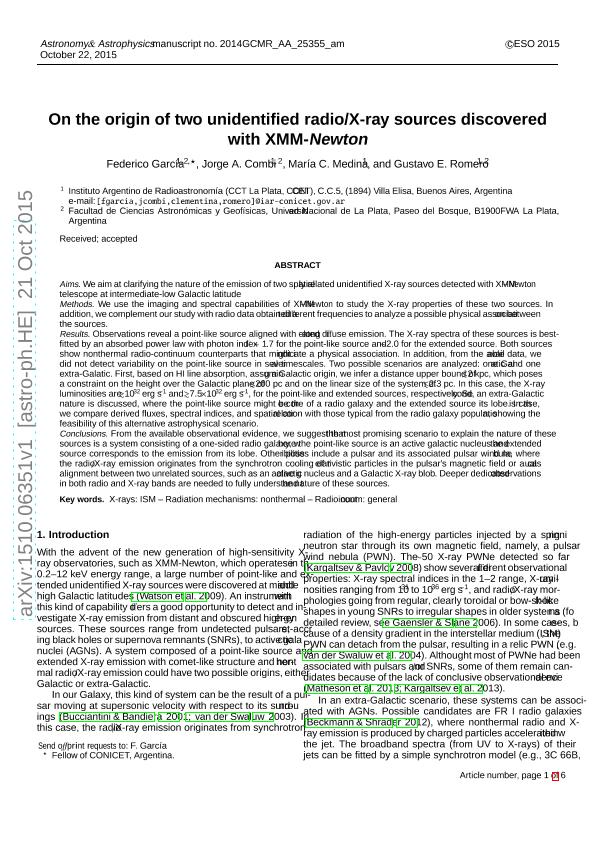Mostrar el registro sencillo del ítem
dc.contributor.author
García, Federico

dc.contributor.author
Combi, Jorge Ariel

dc.contributor.author
Medina, Maria Clementina

dc.contributor.author
Romero, Gustavo Esteban

dc.date.available
2020-10-22T17:10:57Z
dc.date.issued
2015-12
dc.identifier.citation
García, Federico; Combi, Jorge Ariel; Medina, Maria Clementina; Romero, Gustavo Esteban; On the origin of two unidentified radio/X-ray sources discovered with XMM-Newton; EDP Sciences; Astronomy and Astrophysics; 584; 12-2015; 65-71
dc.identifier.issn
0004-6361
dc.identifier.uri
http://hdl.handle.net/11336/116342
dc.description.abstract
Aims. We aim at clarifying the nature of the emission of two spatially related unidentified X-ray sources detected with XMM−Newton telescope at intermediate-low Galactic latitude Methods. We use the imaging and spectral capabilities of XMM−Newton to study the X-ray properties of these two sources. In addition, we complement our study with radio data obtained at different frequencies to analyze a possible physical association between the sources. Results. Observations reveal a point-like source aligned with elongated diffuse emission. The X-ray spectra of these sources is bestfitted by an absorbed power law with photon index Γ ∼ 1.7 for the point-like source and ∼2.0 for the extended source. Both sources show nonthermal radio-continuum counterparts that might indicate a physical association. In addition, from the available data, we did not detect variability on the point-like source in several timescales. Two possible scenarios are analyzed: one Galatic and one extra-Galatic. First, based on HI line absorption, assuming a Galactic origin, we infer a distance upper bound of .2 kpc, which poses a constraint on the height over the Galactic plane of .200 pc and on the linear size of the system of .2.3 pc. In this case, the X-ray luminosities are &1032 erg s−1 and &7.5×1032 erg s−1 , for the point-like and extended sources, respectively. Second, an extra-Galactic nature is discussed, where the point-like source might be the core of a radio galaxy and the extended source its lobe. In this case, we compare derived fluxes, spectral indices, and spatial correlation with those typical from the radio galaxy population, showing the feasibility of this alternative astrophysical scenario. Conclusions. From the available observational evidence, we suggest that the most promising scenario to explain the nature of these sources is a system consisting of a one-sided radio galaxy, where the point-like source is an active galactic nucleus and the extended source corresponds to the emission from its lobe. Other possibilities include a pulsar and its associated pulsar wind nebula, where the radio/X-ray emission originates from the synchrotron cooling of relativistic particles in the pulsar’s magnetic field or a casual alignment between two unrelated sources, such as an active galactic nucleus and a Galactic X-ray blob. Deeper dedicated observations in both radio and X-ray bands are needed to fully understand the nature of these sources.
dc.format
application/pdf
dc.language.iso
eng
dc.publisher
EDP Sciences

dc.rights
info:eu-repo/semantics/openAccess
dc.rights.uri
https://creativecommons.org/licenses/by-nc-sa/2.5/ar/
dc.subject
RADIATION MECHANISMS: NON-THERMAL
dc.subject
RADIO CONTINUUM: GENERAL
dc.subject
STARS: NEUTRON
dc.subject
X-RAYS: ISM
dc.subject.classification
Astronomía

dc.subject.classification
Ciencias Físicas

dc.subject.classification
CIENCIAS NATURALES Y EXACTAS

dc.title
On the origin of two unidentified radio/X-ray sources discovered with XMM-Newton
dc.type
info:eu-repo/semantics/article
dc.type
info:ar-repo/semantics/artículo
dc.type
info:eu-repo/semantics/publishedVersion
dc.date.updated
2020-09-25T16:47:58Z
dc.journal.volume
584
dc.journal.pagination
65-71
dc.journal.pais
Francia

dc.journal.ciudad
Paris
dc.description.fil
Fil: García, Federico. Provincia de Buenos Aires. Gobernación. Comisión de Investigaciones Científicas. Instituto Argentino de Radioastronomía. Consejo Nacional de Investigaciones Científicas y Técnicas. Centro Científico Tecnológico Conicet - La Plata. Instituto Argentino de Radioastronomía; Argentina. Consejo Nacional de Investigaciones Científicas y Técnicas. Centro Científico Tecnológico Conicet - La Plata. Instituto de Astrofísica La Plata. Universidad Nacional de La Plata. Facultad de Ciencias Astronómicas y Geofísicas. Instituto de Astrofísica La Plata; Argentina
dc.description.fil
Fil: Combi, Jorge Ariel. Provincia de Buenos Aires. Gobernación. Comisión de Investigaciones Científicas. Instituto Argentino de Radioastronomía. Consejo Nacional de Investigaciones Científicas y Técnicas. Centro Científico Tecnológico Conicet - La Plata. Instituto Argentino de Radioastronomía; Argentina. Consejo Nacional de Investigaciones Científicas y Técnicas. Centro Científico Tecnológico Conicet - La Plata. Instituto de Astrofísica La Plata. Universidad Nacional de La Plata. Facultad de Ciencias Astronómicas y Geofísicas. Instituto de Astrofísica La Plata; Argentina
dc.description.fil
Fil: Medina, Maria Clementina. Provincia de Buenos Aires. Gobernación. Comisión de Investigaciones Científicas. Instituto Argentino de Radioastronomía. Consejo Nacional de Investigaciones Científicas y Técnicas. Centro Científico Tecnológico Conicet - La Plata. Instituto Argentino de Radioastronomía; Argentina. Consejo Nacional de Investigaciones Científicas y Técnicas. Centro Científico Tecnológico Conicet - La Plata; Argentina
dc.description.fil
Fil: Romero, Gustavo Esteban. Consejo Nacional de Investigaciones Científicas y Técnicas. Centro Científico Tecnológico Conicet - La Plata. Instituto de Astrofísica La Plata. Universidad Nacional de La Plata. Facultad de Ciencias Astronómicas y Geofísicas. Instituto de Astrofísica La Plata; Argentina. Provincia de Buenos Aires. Gobernación. Comisión de Investigaciones Científicas. Instituto Argentino de Radioastronomía. Consejo Nacional de Investigaciones Científicas y Técnicas. Centro Científico Tecnológico Conicet - La Plata. Instituto Argentino de Radioastronomía; Argentina
dc.journal.title
Astronomy and Astrophysics

dc.relation.alternativeid
info:eu-repo/semantics/altIdentifier/url/http://adsabs.harvard.edu/abs/2015A%26A...584A..65G
dc.relation.alternativeid
info:eu-repo/semantics/altIdentifier/doi/http://dx.doi.org/10.1051/0004-6361/201425355
dc.relation.alternativeid
info:eu-repo/semantics/altIdentifier/arxiv/https://arxiv.org/abs/1510.06351
Archivos asociados
